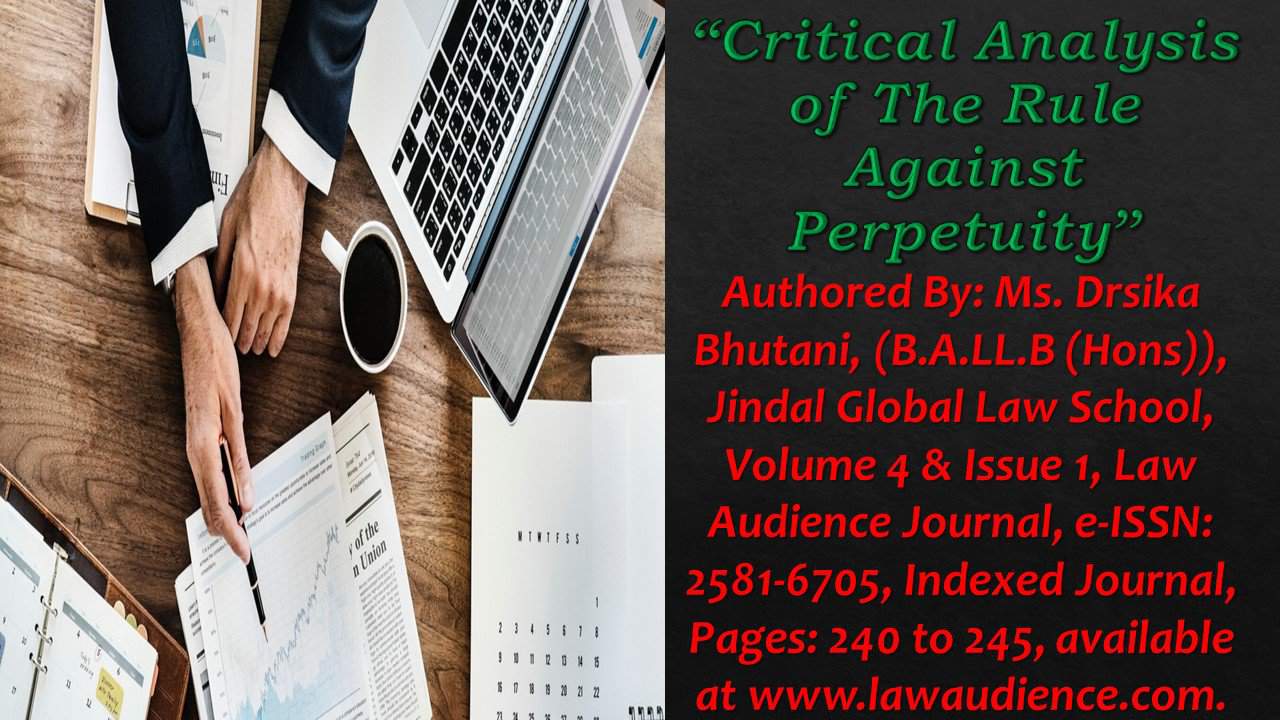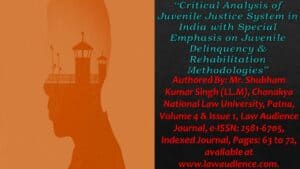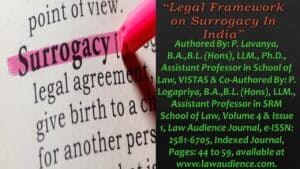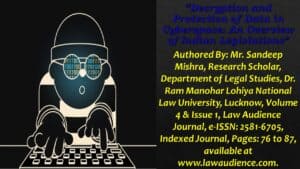Click here to download the full paper (PDF)
Authored By: Ms. Drsika Bhutani, (B.A.LL.B (Hons)), Jindal Global Law School,
Click here for Copyright Policy.
CRITICAL ANALYSIS OF THE RULE AGAINST PERPETUITY:
The word “Perpetuity” according to Oxford dictionary means “the state or quality lasting forever.” However, the legal definition, in terms of property law means creating an interest at a time that would take effect only after perpetuity. According to the Norfolk Duke’s case,[1] “A perpetuity is a settlement of an estate or an interest in tail, with such remainders over that no act of alienation on the present tenant in tail can ever bar those remainders; but they must continue perpetually, and be as a cloud hanging over the present possession: such perpetuities fight against God, by affecting a stability which human providence can never attain to, and are utterly against the reason and policy of the common law.”
However, the modern definition as given by Jarman states it to be as a restriction upon the alienation of the property by transfer for eternity.[2] In In Re Hollis’ Hospital[3] it was observed why exactly was perpetuity against the policy and reason of law stated by Justice Byrne when he talked about Rule Against Perpetuity acts as a restraint on trade and commerce, and hence contrary to the public policy. The Free Market Theory by Adam Smith was cited by him along with the Duke of Norflock’s case. He further goes onto explain that limited future interest may bar the successors of property from alienating it and hence resulting in accumulation of property within specific families. Thus, it can be observed that this rule further alienates the property that is required necessarily to make the property productive and also to increase its societal income.
According to the Transfer of Property Act, 1882, Section 14 defines the Rule against Perpetuity- “No transfer of property can operate to create an interest which is to take effect after the life-time of one or more persons living at the date of such transfer, and the minority of some person who shall be in existence at the expiration of that period, and to whom, if he attains full age, the interest created is to belong.” Here, ‘Time’ attached to the law shall be deemed to be the lifetime of a person having an interest in himself, together with a minority duration of a minor who has an interest in a property that is of an absolute nature.[4] The term has also been defined as “Rule against remoteness of vesting” in Common Law. The particular ‘Time’ for the law here is deemed to be the lifetime of the last individual in a certain set of people who lived in addition to 21 years when the interest was created. Perpetuities and Accumulation Act of 1964 further defines it.
The principle behind enacting the rule against perpetuity in different jurisdictions is that an individual with an absolute interest should not be able to alienate the interest to the detriment of himself. The transfer of interest in such a way as to make it inalienable is an act which is considered to be detrimental to the interests themselves. This concept is based on “law gives priority to alienation over accumulation”- Latin maxim- “alienatio rei praefertur juri accrescendi.” The application of this law can be seen in various laws across the U.K. and cases in Common Law countries. Therefore, portraying the preference of upholding alienation above stagnant accumulation.[5] Section 13 of Transfer of Property Act, 1882, which provides that– “Where, on a transfer of property, an interest therein is created for the benefit of a person not in existence at the date of the transfer, subject to a prior interest created by the same transfer, the interest created for the benefit of such person shall not take effect, unless it extends to the whole of the remaining interest of the transferor in the property.”- goes hand in hand with section 14 of The Transfer of Property Act, (aforementioned) and are to be read together to understand the underlying principles of the rules.
Under Transfer of Property Act, 1882, transfer of Property directly in the favour of an unborn person is not permitted. It is a prerequisite requirement for the property to be vested in a person who is between the dates of the said transfer and of that of the coming into the existence of the yet unborn person, for the property cannot be directly transferred. It is further established that for an interest which is created in favour of an unborn person, should constitute the entirety of the remaining interest. Section 13 basically holds that a person who is disposing off the Property to another person, is not able to fetter the free disposition of the said property, into the hands of more than one generation. It, however, does not prohibit or stop successive interests from being created in favour of those persons that are living at the time of the transfer. It is only prohibited in the case of that of an unborn person. In addition to these to section 13 and Section 14 respectively are almost identical Sections of Indian Succession Act, (ISA) 1925’ Section 113 and Section 114. The difference being that The Transfer of Property Act deals with Inter vivos transfer of property and on the other hand, the Indian Succession Act talks about transfer of property which is to take effect only upon the death of the testator.
In the case of Raj Bajrang Bahadur Singh vs. Thakurain Bakhtraj Kuer[6], it was established that Section 13 of The Transfer of Property Act controls Section 113 of The Transfer of Property Act and are to be read together. It was further observed that “It is quite true that no interest could be created in favour of an unborn person but when the gift is made to a class or series of persons, some of whom are in existence and some are not, it does not fail in its entirety; it is valid with regard to the persons who are in existence at the time of the testator’s death and is invalid as to the rest.”
According to the Transfer of Property Act, under Section 18, it is provided that “Transfer in perpetuity for benefit of public.—The restrictions in sections 14, 16 and 17 shall not apply in the case of a transfer of property for the benefit of the public in the advancement of religion, knowledge, commerce, health, safety or any other object beneficial to mankind.” Poses for an exception to Section 14 (of Transfer of Property Act.) It provides protection from the Rule against Perpetuity for when the transfer is in favour of public, which can be for advancement of commerce, religion, knowledge, safety, health and so on and forth for any benefit to the mankind. This, however, does not create an interest in property. Therefore, the duration of the utilisation, enjoyment and transfer of property are limited under the Rule Against Perpetuity. However, the Rule Against Perpetuity put together with relevant sections of the Transfer of Property Act, are deemed complex and somewhat abstract in their respective application, especially when it is seen through the perspective of the transferor. Regardless of the most effective of intentions, the final word of the beneficiary or grantee may be at a loss of their intended interests with regards to the drafting of the relevant covenant.
In today’s world, most transactions take place by creating an equitable interest in a trust, this provides broad provisions for reinvestment and sale. The ‘Prudent man rule’ is to be adhered by the said trustees while selling or reinvesting within the property so that it is productive. In this rule it was stated by Justice Samuel Putanam in the case of Harvard College vs. Amory[7], that the trustee is required to keep the following factors in mind while investing trust assets: the needs of the beneficiary, the need to preserve the estate and the amount and regularity of the income. It was said that the trustee would have to invest the trust asset as a prudent man to invest his own property. This rule seeks to allow the trustee to take affirmative action to avoid making the trust property unproductive. It does not, however, cause the investment to take an unreasonably high chance of extra growth. In India, The trust law in is governed by the Indian Trust Act, 1882. The Indian Trust Act essentially has a rigid framework for the sale of trust assets.
However, the case law on the matter has begun to follow the English and American trends. Section 37 of the Act provides that the trustee may sell the trust property only if it is empowered by the trust instrument to do so. The change was enforced in the case of Shirinbai Merwanji Dalal[8], In it has been provided that in the event that the situation is dire or that there is no income from the trust or that the trust property is in serious need of repairs, the Courts may allow the selling of trust property. This was also observed in the case of D.V. Gundappa[9]. Transfer of trust is governed by these laws in most of the common law countries which allow a sale/ reinvestment in Trust assets even without a specific provision. The Rule against Perpetuity loses its actual essence when seen in light with these provisions, for the aim is replaced. It can be said that interest is consistent with alienation and productivity of property. The estate tax was banned in India in the year 1986, this simply results in benefiting a handful of people in the country with regards to overall economic growth. The policy of direct taxes does not target the handful of people in the same manner as it targets the people who do not fall into the aforementioned category of handful people. This accumulation of wealth within specific families is given the term of Carnegie Effect which was posed by Andrew Carnegie.
Whilst analysing the Rule of Perpetuity, various subtleties with regards to its treatment in the Indian Jurisdiction come forth. Rule of Perpetuity has always posed as an equity protection, so it can make sure of the fact that the property in question can be allowed to be freely alienated and to make sure that there is no stagnant accumulation. The rationale for taking away the ability to transfer which ends up making the property inalienable is to promote public interest and in case where the property is held in one place for far too long, to prevent any detriment which is being conferred onto the property. For this leads to the deterioration of a property which could have easily been used for public welfare /benefit. It can be seen that there have been various instances where it has been tried to get round this application of the rule by using the age-old weapon of legal ambiguity that is there with regards to the said rule.
Taking into consideration, as of now, agreements of such kinds are getting the benefit from the legal ambiguity that exists around this rule are those with regards to the personal contracts. This reinforces that fact that was mentioned before about the accumulation of wealth. Such a situation shows the fact that this leads the society to move forward, in the direction of accumulation of wealth and the property rather than that of simple alienation. It can be hence said that the Rule of Perpetuity is void of the former envisioned spirit and need back in the 17th Century. The evolution of the nature of the law with regards to the pre contemporary requirements can be seen with regards to the Rights that are given to the trustee to sell and reinvest in the trust asset. It can be seen that Rule against Perpetuity under Section 14 of the Transfer of Property Act, functions as the social, legal and economic structure that has been long dead and has simply failed to stay face to face with the evolution it has gone through for such a long time in the world. It is essential to focus on how this law is responded to by the courts of law and how the ambiguity that revolves around this is law is surrounded by. It is also needed to for it to simultaneously uphold the legal principle that has encouraged alienation over that of accumulation. This can either mean to approach the law as it was envisioned in the English law or to declare the law void and thus, revoked.
Cite this article as:
Ms. Drsika Bhutani, “Critical Analysis of The Rule Against Perpetuity”, Vol.4 & Issue 1, Law Audience Journal (e-ISSN: 2581-6705), Pages 240 to 245 (10th July 2022), available at https://www.lawaudience.com/critical-analysis-of-the-rule-against-perpetuity/.
Footnotes & References:
[1] 22ER 931.
[2] Thomas Jarman, A TREATISE ON WILLS (Sweet & Maxwell, 7th ed.), 1959, p. 285.
[3] In Re Hollis’ Hospital 2 Ch. 540, 553 (1899).
[4] Section 14, Transfer of Property Act 1882.
[5] VepaSarthi, LAW OF TRANSFER OF PROPERTY, (Lexis Publications, 3rd edn.), 2002, p. 292.
[6] Raj Bajrang Bahadur Singh vs. Thakurain Bakhtraj Kuer (AIR 1953 Supreme Court 7).
[7] Harvard College v Amory (1830) 26 Mass (9 Pick) 446.
[8] Shirinbai Merwanji Dalal (1919) 21 BOMLR 41.
[9] D.V. Gundappa AIR 1951 Kant 6.




